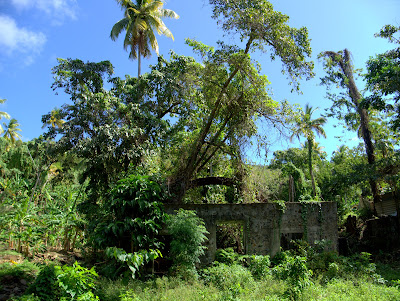Back from a great holiday in St. Lucia, I'll share a few images now.
According to wikipedia, in 1834 Britain abolished slavery in St. Lucia. Even after abolition, all former slaves had to serve a four-year "apprenticeship" which forced them to work for free for their former masters for at least three-quarters of the work week. They achieved full freedom in 1838.
The cuisine of St. Lucia today is wonderfully healthy with copious fruits, vegetables and fish.
Formerly, meat for slaves would have included the cheapest cuts that the plantation owners rejected -- pigs' tails, trotters and cheeks for example. Such cuts are salted and sold in packs at room temperature to this day.
My thanks to the St Lucian below, who explained how the meat needs to be soaked to remove the salt and how it is then cooked with vegetables.
It is delicious, he claimed. Note the pig's snout. It would be great to see a picture of the final dish.
Arrowhead, Sagittaria sagitifolia with Blue-tailed damselfly. RSPB Pulborough Brooks 2 July 2024
For illustrated talks on natural history and history see www.peterlovetttalks.co.uk
For illustrated talks on natural history and history click here for www.peterlovetttalks.co.uk
Thursday 31 January 2013
Wednesday 30 January 2013
Industrial archaeology of St. Lucia - a derelict sugar cane factory

This derelict roofless building, overgrown with creepers, hides relics of a past age of British empirical power.
St. Lucia did not escape the terror of the French revolution in 1789. Plantation owners were guillotined. The island changed "ownership" seven times between the British and the French, which, to this day, provides many French place names and the Creole language with great French influences.
Sugar cane is no longer a commercially important crop on the island. This isolated ruin of a cane crushing plant is therefore of extraordinary historical interest.
This is the view from the right hand side of the previous picture. The massive cogs were driven by the water wheel, of which you can just see a couple of spokes.The wheel is huge.
Here is an English aristocrat for comparison.
The year of manufacture, 1876 by W & A McOnie from Glasgow. Those were the days when Britain ruled the waves... and the empire.
Above and below are views from inside the building.
It is amazing that these relics are still here... and scary that they might disappear as scrap iron at any moment.
By the way, the cast iron structure of the market in Castries was made in Birmingham. The island is abundant with relics from the past.
We were able to view this site thanks to HF Holidays and our guide, "Vision".
St. Lucia is a great place to visit -- all the more so if you have a great guide.
An expert on the plants, birds, culture and history of St. Lucia, Valance Rodney James ("Vision") is one such expert guide.
Saturday 26 January 2013
Vanilla orchid in St. Lucia, Millet bird sanctuary
Vanilla pods come from a climbing orchid like the one above.
This one has not yet produced vanilla pods. Fertilisation of the flowers needs a particular insect and it is possible that the spraying of surrounding banana plants has wiped out the necessary insects.
That is a good argument for buying organic, fairtrade St. Lucian bananas.
This one has not yet produced vanilla pods. Fertilisation of the flowers needs a particular insect and it is possible that the spraying of surrounding banana plants has wiped out the necessary insects.
That is a good argument for buying organic, fairtrade St. Lucian bananas.
Thursday 17 January 2013
Wild orchid in St Lucia Millet bird sanctuary and nature trail
It is not a native orchid to St. Lucia but is believed to have been blown in (perhaps from Africa) with the past Hurricane David.
Wednesday 9 January 2013
Hazel in flower in January
These wind pollinated hazel flowers are very early.
Wednesday 2 January 2013
Osteospermum in flower on New Year's day
This Osteospermum sp. is in flower on New Year's day, despite the torrential rains and occasional frosts of the winter so far.
Happy New Year to all.
Primulas are also in flower -- for some weeks already.
Happy New Year to all.
Primulas are also in flower -- for some weeks already.
Subscribe to:
Posts (Atom)



















